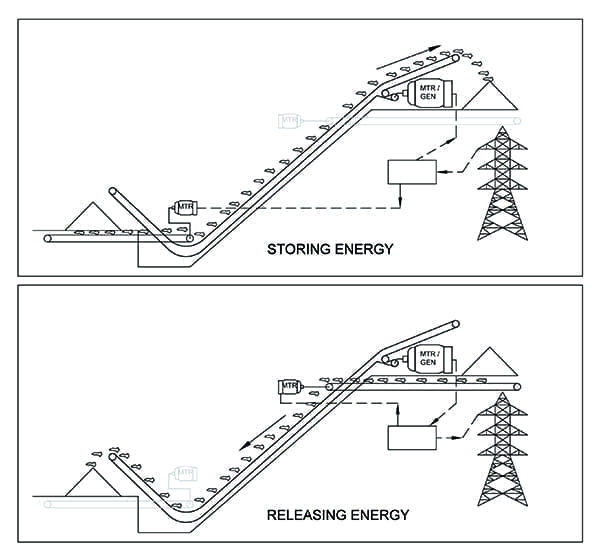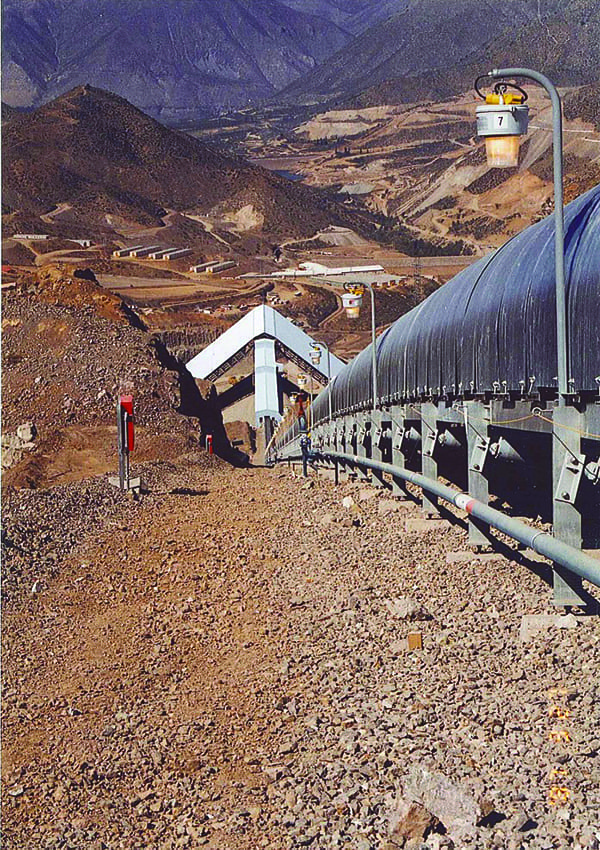Conveyor Energy Storage: A Battery and Pumped Hydro Alternative
A new conveyor-based system offers an alternative energy storage technology. The heart of the system is a reversible conveyor belt that converts between electrical energy and gravitational potential energy by transporting bulk granular materials between two stockpiles at different elevations.
The U.S. Department of Energy reported that the total solar energy production in the U.S. increased from 28,924 GWh in 2014 to 96,147 GWh in 2018. During the same time period, it said the total energy produced by wind in the U.S. increased from 181,655 GWh to 274,952 GWh. Grid operators must keep the supply and demand for energy in balance. Traditionally, operators balanced supply and demand for electricity by modifying the supply to match demand. However, wind and solar generators cannot change the energy they supply as easily as conventional coal and gas power plants. To balance the supply and demand for power, many grid operators with large solar and wind assets are utilizing energy storage facilities to increase the demand for power when the supply would otherwise outstrip demand.
Currently, there are four commercialized energy storage technologies deployed in the U.S. They are pumped hydro storage (PHS), compressed air energy storage (CAES), advanced battery energy storage (ABES), and flywheel energy storage (FES). As of June 2018, 94% of U.S. energy storage assets were PHS. PHS commands a huge market share because unlike ABES its lifetime is measured in decades instead of years. PHS technology was proven more than a century ago, and the cost per MWh stored and dispatched are lower than all its competitors.
PHS systems require large volumes of water that are not readily available in all regions of the world. Conveyor Dynamics Inc. (CDI) has developed a new energy storage system analogous to PHS, but instead of transporting water between reservoirs, the conveyor energy storage (CES) system stores and releases energy by moving bulk granular material between stockpiles. Like PHS, CDI’s system utilizes low-cost and proven equipment that has been deployed for decades. The company expects the CES system to provide a competitive alternative to PHS in arid regions of the world.
 |
|
1. The conveyor energy storage system utilizes a motor-generator scheme similar to technology employed at a pumped hydro storage facility. When energy is to be stored, the motor-generator drives a conveyor to move bulk granular material from a lower stockpile to an upper stockpile. When energy is to be supplied by the system, the motor-generator is driven by the conveyor as the bulk granular material is transported from the upper stockpile back to the lower stockpile through gravitational force. Courtesy: Conveyor Dynamics Inc. (CDI) |
Figure 1 shows the operating principle of the CES system. The heart of the system is a reversible conveyor belt that converts between electrical energy and gravitational potential energy by transporting bulk granular materials between two stockpiles at different elevations. The reversible conveyor is driven by an electric motor-generator controlled with a four-quadrant inverter drive.
To store energy the reversible conveyor receives ore from feeder conveyors below the low-elevation stockpile and discharges the material onto the high-elevation stockpile. To release energy, the conveyor reverses direction, receives material from feeder conveyors under the high-elevation stockpile, and discharges this material onto the lower-elevation stockpile.
Rapid changes to the power generated or stored by the system are possible by changing the belt speed of the conveyor within seconds. If the CES is operating in the storage mode, increasing speed will increase the power demand and decreasing speed will reduce the power demand. If the CES is operating in generation mode, increasing speed will reduce the generated power, and reducing speed will increase the generated power.
Technical Feasibility
CDI has designed some of the largest incline and decline conveyors in the mining industry. In 1988, the company designed and commissioned a large incline underground conveyor at the Palabora mine in South Africa that was 1,065 meters long and gained 295 meters of elevation. This conveyor consumed 6,277 kW of power while transporting 6,495 metric tons per hour (t/hr) of copper ore.
 |
|
2. This image shows a portion of the Los Pelambres regenerative conveyor in Chile. The largest conveyor at the site is 5,967 meters long and has a 535.8-meter elevation change. Courtesy: CDI |
In 2000, CDI designed and commissioned three large decline conveyors at the Los Pelambres mine in Chile (Figure 2). The largest was 5,967 meters long and lost 535.8 meters of elevation. Today, this single conveyor generates approximately 9 MW while transporting 9,900 t/hr.
As a base case for analysis, a CES system was modeled featuring a 1,200-meter-long conveyor, transporting 15,000 t/hr of material between two conical stockpiles, each with a maximum height of 33 meters. When charging, the material gains 325 meters of elevation, and when discharging, the material loses 290 meters of elevation. This system can store 120 MWh of energy and produce 10 MW peak electrical power output.
The storage capacity of the CES system is limited only by the size and geometry of the stockpiles, and the difference in elevation between them. The power the system develops is a function of the rate of bulk material transported.
Cost and Efficiency
In the CES system, the elevation loss is always less than the elevation gain, because the distance from the bottom of the lower stockpile to the top of the upper stockpile is greater than the distance from the bottom of the upper stockpile to the top of the lower stockpile. This is a major source of inefficiency in the CES system. To minimize this elevation difference, luffing discharge pulleys can be utilized at both ends of the conveyor so that material always discharges at the lowest possible height, following the top of the growing storage stockpile.
With conventional conveyor technology, the base CES system would have a roundtrip efficiency of approximately 60%. This efficiency would increase to about 70% using low-rolling-resistance rubber belts and low-friction idler rollers.
The system efficiency can be increased further by conveying on steeper grades using one of several high-angle conveying technologies. The angle chosen for the base case is typical for conventional large mining conveyors, but with advanced high-angle conveyors, it is possible to convey bulk materials vertically.
Comparison with Commercialized Alternatives
The range of efficiencies that commercialized energy storage systems have achieved are:
- ■ PHS = 76%–85%
- ■ CAES = 42%–55%
- ■ ABES = 60%–95%
- ■ FES = 85%–87%
FES systems are mainly used for power management rather than energy storage, so they would not normally compete with CES applications. The only competing commercialized technology the CES system is likely to outperform from an efficiency perspective is CAES. For a PHS, ABES, or CAES system of similar size to the CES base design, the CES system is likely to cost less than the other options.
The cost of constructing a CES system depends heavily on the amount of civil work required on the site. CDI estimates that a typical total project cost for a medium-duration (0.5 hr to 2 hr) 120-MWh CES system able to generate 10 MW of power would be approximately $25 million dollars. On a per-kW basis, this represents $2,470/kW. For comparison, the International Energy Agency reported in March 2014 that the initial investment cost of commercialized systems was in the following ranges:
- ■ PHS = $500/kW–$4,600/kW
- ■ CAES = $500/kW–$1,500/kW
- ■ ABES = $300/kW–$3,500/kW
Although costs may have decreased since that time, it remains likely that a CES system is comparable in cost to existing technologies on a kW output basis.
On an installed-storage-capacity basis, the CES system costs approximately $208/kWh. Where feasible, PHS is still the clear winner, costing less than $100/kWh, but in arid regions of the world, the CES system is a competitive, reliable alternative to ABES systems. Typically, ABES systems cost $750/kWh to $2,000/kWh.
The CES system is a relatively low-cost method of storing a large amount of energy without the environmental impacts and geographical limitations of PHS. On an installed-storage-capacity-per-kWh basis, it is one-quarter the cost of comparable battery systems and at least comparable on a cost-per-kW-output basis. The CES system could provide a robust and reliable low-cost alternative to PHS in arid regions of the world where steep natural topography is present. ■
—Andrew Jennings, PE ([email protected]) is president of Conveyor Dynamics Inc.